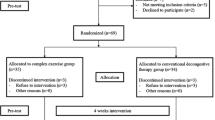Abstract
Background
Wound seroma is one of the most frequent complications of mastectomy, but an effective strategy Tor its prevention has not yet been established. The purpose of this study was to determine the effectiveness of delayed shoulder exercise on the prevention of wound seroma after partial or total mastectomy with axillary dissection for the treatment of cancer.
Methods
This study prospectively randomized two exercise schemes after mastectomy with axillary lymph node dissection. The immediate exercise group (n=58) started shoulder exercise on the first postoperative day. In the delayed exercise group (n=58) the movement of the upper limb was limited to usual daily activities during the first postoperative week.
Results
Preoperative levels of shoulder function were regained within one month when shoulder exercise was delayed for one week after operation. Significant decrease of drainage volume and lower incidence of seroma formation were seen in the delayed exercise group.
Conclusion
These observations suggest that seven days of unrestricted movement and avoiding active exercise of the shoulder joint, is the optimal routine reduce seroma formation after mastectomy.
Similar content being viewed by others
References
Healey JE: Role of rehabilitation medicine in the care of the patient with breast cancer.Cancer 28:1666–1671, 1971.
Pollard R, Callum KG, Altaian DG,et al: Shoulder movement following mastectomy.Clin Oncol 2:343–349, 1976.
Lotze MT, Duncan MA, Gerber LH,et al: Early versus delayed shoulder motion following axillary dissection.Ann Surg 193:288–295, 1981.
Jansen RFM, Van Geel AN, De Groot HGW,et al: Immediate versus delayed shoulder exercises after axillary lymph node dissection.Am J Surg 160:481–484 1990.
Flew TJ: Wound drainage following radical mastectomy; The effect of restriction of shoulder movement.Br J Surg 66:302–305, 1979.
Van Der Horst Ch MAM, Kenter JAL, De Jong MT,et al: Shoulder function following early mobilization of the shoulder after mastectomy and axillary dissection.Neth J Surg 37:105–108, 1985.
Dawson I, Stam L, Heslinga JM,et al: Effect of shoulder immobilization on wound seroma and shoulder dysfunction following modified radical mastectomy; A randomized prospective clinical trial.Br J Surg 76:311–312, 1989.
Author information
Authors and Affiliations
About this article
Cite this article
Abe, M., Iwase, T., Takeuchi, T. et al. A randomized controlled trial on the prevention of seroma after partial or total mastectomy and axillary lymph node dissection. Breast Cancer 5, 67–69 (1998). https://doi.org/10.1007/BF02967417
Received:
Accepted:
Issue Date:
DOI: https://doi.org/10.1007/BF02967417




